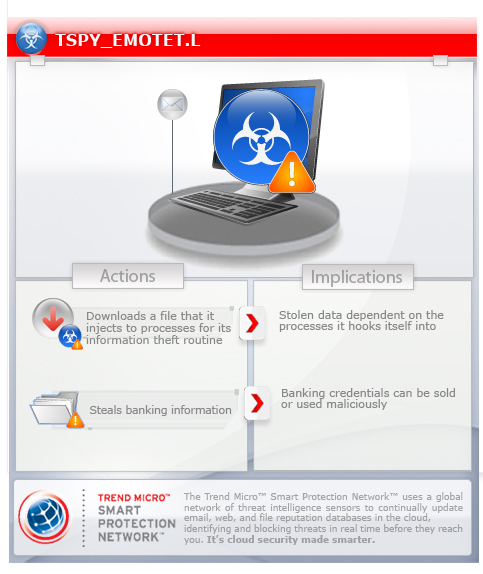TSPY_EMOTET.L
Windows 2000, Windows Server 2003, Windows XP (32-bit, 64-bit), Windows Vista (32-bit, 64-bit), Windows 7 (32-bit, 64-bit)


Threat Type: Spyware
Destructiveness: No
Encrypted:
In the wild: Yes
OVERVIEW
This spyware sniffs network packets to steal information. It arrives via spammed messages aimed at German online banking users.
To get a one-glance comprehensive view of the behavior of this Spyware, refer to the Threat Diagram shown below.

This spyware arrives as an attachment to email messages spammed by other malware/grayware or malicious users. It arrives on a system as a file dropped by other malware or as a file downloaded unknowingly by users when visiting malicious sites.
It executes then deletes itself afterward.
As of this writing, the said sites are inaccessible.
It deletes the initially executed copy of itself.
TECHNICAL DETAILS
Arrival Details
This spyware arrives as an attachment to email messages spammed by other malware/grayware or malicious users.
It arrives on a system as a file dropped by other malware or as a file downloaded unknowingly by users when visiting malicious sites.
Installation
This spyware drops the following copies of itself into the affected system:
- %Application data%\Microsoft\{random 3 characters}{random string}.exe
It drops the following files:
- %Application data%\Microsoft\{random number}.bat - This will delete the executed copy and delete itself after
It executes then deletes itself afterward.
It adds the following mutexes to ensure that only one of its copies runs at any one time:
- {process id}I
- {process id}M
It stays memory-resident by creating remote threads:
- explorer.exe
Autostart Technique
This spyware adds the following registry entries to enable its automatic execution at every system startup:
HKEY_CURRENT_USER\Software\Microsoft\
Windows\CurrentVersion\Run
{random 3 characters}{random string}.exe = "%Application data%\Microsoft\{random 3 characters}{random string}.exe"
Other System Modifications
This spyware adds the following registry keys:
HKEY_CURRENT_USER\Software\Microsoft\
Office\Common\{random 1}
HKEY_CURRENT_USER\Software\Microsoft\
Office\Common\{random 1}\
{random 1}RS
HKEY_CURRENT_USER\Software\Microsoft\
Office\Common\{random 1}\
{random 1}SS
HKEY_CURRENT_USER\Software\Microsoft\
Office\Common\{random 1}\
{random 1}PS
Download Routine
This spyware connects to the following URL(s) to download its component file(s):
- {BLOCKED}.{BLOCKED}.146.109:8080
- {BLOCKED}2.{BLOCKED}4.110.228:8080
- {BLOCKED}.9.{BLOCKED}6.20:8080
- {BLOCKED}2.{BLOCKED}3.232.235:8080
- {BLOCKED}2.{BLOCKED}3.237.6:8080
- {BLOCKED}.{BLOCKED}.0.5:8080
- {BLOCKED}.{BLOCKED}.152.124:8080
- {BLOCKED}.{BLOCKED}.69.191:8080
- {BLOCKED}.{BLOCKED}.218.166:8080
- {BLOCKED}4.{BLOCKED}.183.196:8080
- {BLOCKED}.{BLOCKED}1.25.23:8080
As of this writing, the said sites are inaccessible.
Other Details
This spyware deletes the initially executed copy of itself
NOTES:
{Random string} can be one of the following:
- windows
- video
- update
- system
- sock
- share
- setup
- serial
- mgr32
- error
- edit32
- crypt
- config
- common
- cap32
- boot
- bios
- audio
- api32
The downloaded PE file is a DLL. This DLL is also injected to all processes and is responsible for intercepting and logging outgoing network traffic.
It targets German banks and possible script injections:
- banking.gecapital.de/
- comdirect.de
- cortalconsors.de
- finanzportal.fiducia.de
- onlinebanking.psd-bank.de/
- postbank.de
- professionalpartners.cortalconsors.de
- ptlweb/WebPortal
- ssl2.haspa.de/onlinefiliale/banking/services
- ssl2.haspa.de/onlinefiliale/banking/authenticate/login
SOLUTION
Step 1
Before doing any scans, Windows XP, Windows Vista, and Windows 7 users must disable System Restore to allow full scanning of their computers.
Step 2
Scan your computer with your Trend Micro product and note files detected as TSPY_EMOTET.L
Step 3
Restart in Safe Mode
Step 4
Delete this registry value
Important: Editing the Windows Registry incorrectly can lead to irreversible system malfunction. Please do this step only if you know how or you can ask assistance from your system administrator. Else, check this Microsoft article first before modifying your computer's registry.
- In HKEY_CURRENT_USER\Software\Microsoft\Windows\CurrentVersion\Run
- {random 3 characters}{random string}.exe = "%Application data%\Microsoft\{random 3 characters}{random string}.exe"
- {random 3 characters}{random string}.exe = "%Application data%\Microsoft\{random 3 characters}{random string}.exe"
Step 5
Restart in normal mode and scan your computer with your Trend Micro product for files detected as TSPY_EMOTET.L. If the detected files have already been cleaned, deleted, or quarantined by your Trend Micro product, no further step is required. You may opt to simply delete the quarantined files. Please check this Knowledge Base page for more information.
Step 6
The following created files/folders/registry keys/registry entries cannot be identified by the user since there are no reference values in the created key. The only way it can be identified is by comparing the present system information with a backup. Note that the said components do not have to be deleted since it won't be harmful to the system.
- In HKEY_CURRENT_USER\Software\Microsoft\Office\Common
- {random 1}
- {random 1}
Step 7
Scan your computer with your Trend Micro product to delete files detected as TSPY_EMOTET.L. If the detected files have already been cleaned, deleted, or quarantined by your Trend Micro product, no further step is required. You may opt to simply delete the quarantined files. Please check this Knowledge Base page for more information.
Did this description help? Tell us how we did.



